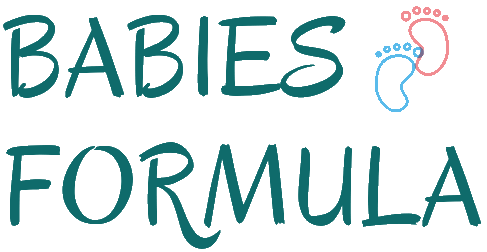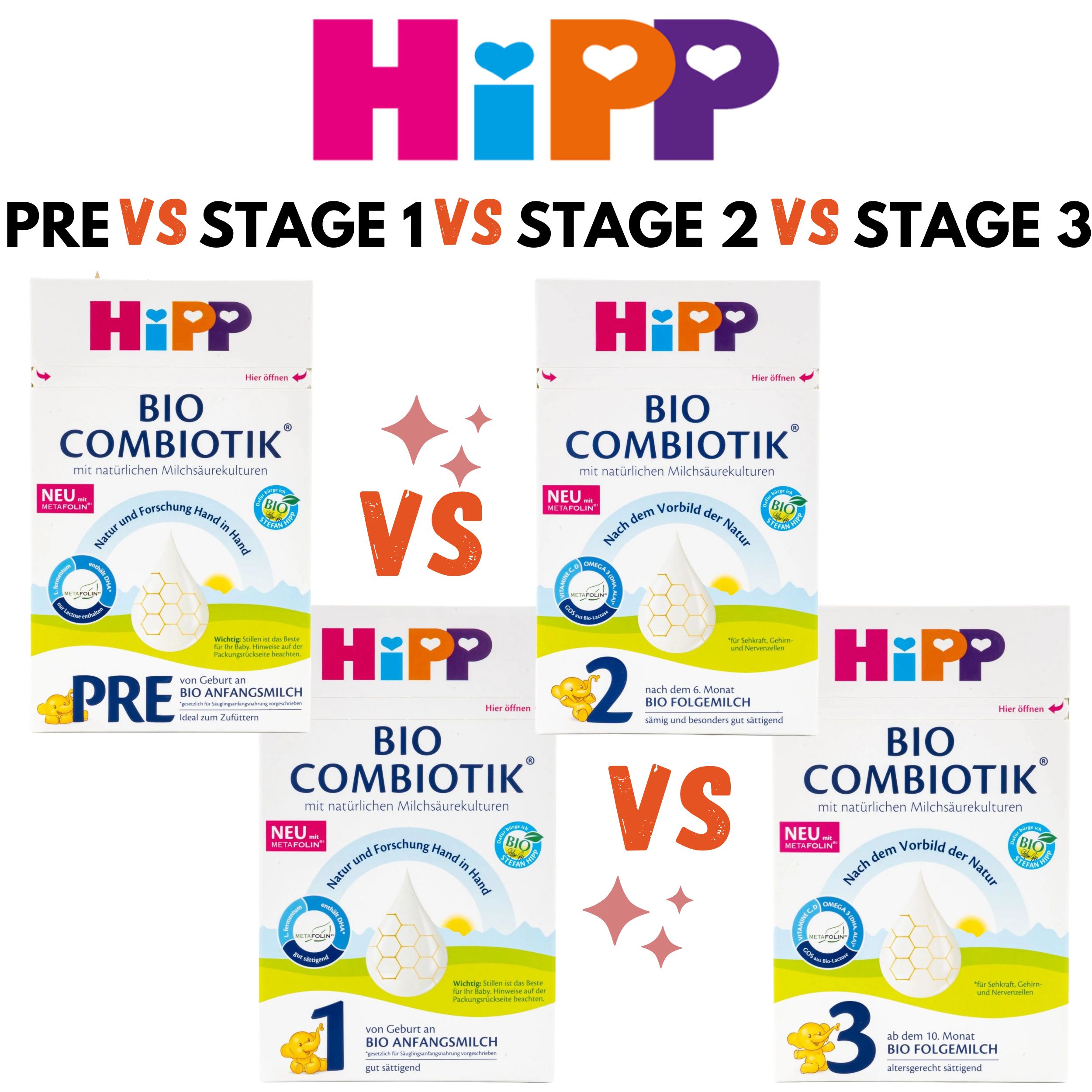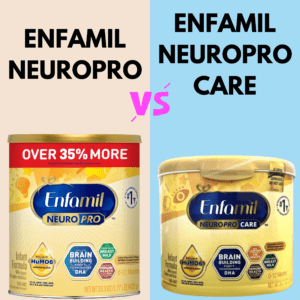Comparison Chart:
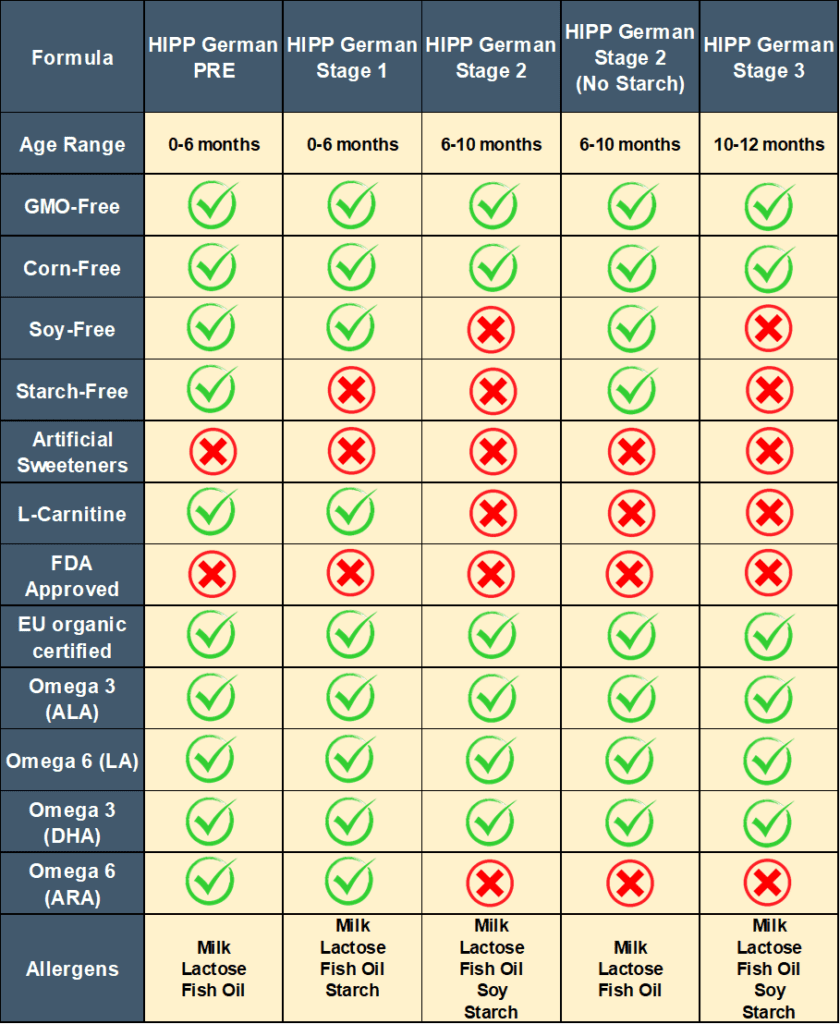
“When you buy something using my links, I may earn a small commission at no additional cost to you. This is a kind of support to me. This website doesn’t accept money for reviews. “
The main differences between HiPP German PRE, Stage 1, Stage 2, Stage 2 (no starch), and Stage 3 are in terms of:
Age Range:
HiPP German PRE and Stage 1 are tailored for infants aged 0-6 months, providing essential nutrition during the crucial early stages of life. As babies grow, HiPP German Stage 2 and Stage 2 (no starch) formulas become suitable from 6-10 months, addressing their evolving dietary needs. Finally, HiPP German Stage 3 is designed for babies aged 10-12 months, catering to their developmental milestones.
Soy Content:
HiPP German PRE, Stage 1, and Stage 2 (no starch) formulas are soy-free, making them ideal for infants with soy sensitivity or allergies. In contrast, HiPP German Stage 2 and Stage 3 contain Emulsifier Lecithins, which may include soy-based components. Parents should consider these differences when selecting a formula for their baby, especially if soy is a concern.
Starch Content:
For babies with potential starch sensitivities, HiPP German PRE and Stage 2 (no starch) are the preferred options as they are starch-free. On the other hand, HiPP German Stage 1, Stage 2, and Stage 3 formulas incorporate starch among their carbohydrate sources, offering an energy source suitable for growing infants.
Starch can contribute to a feeling of fullness and satiety in babies. This can help regulate feeding patterns and prevent excessive feeding, ultimately supporting healthy growth and weight gain.
Protein Composition:
HiPP German PRE and Stage 1 formulas have an important level of L-carnitine, which is required by the European Commission in Infant formulas (0-6 months). However, this addition is not present in HiPP German Stage 2 and Stage 3 formulas because it’s optional.
Omega-6 Fatty Acids:
Omega-6 fatty acids are crucial for a baby’s growth and development. HiPP German PRE and Stage 1 formulas provide a comprehensive package by including both Linoleic acid and Arachidonic acid as sources of omega-6. In contrast, HiPP German Stage 2 and Stage 3 formulas contain only Linoleic acid as a source of Omega 6 because in this stage solid foods are introduced that are enriched with Omega 6.
The European Commission required only that DHA be present in all stages, but ARA is optional.
Related: HiPP German Vs Dutch Vs UK: What’s The Difference?
Ingredients Comparison:
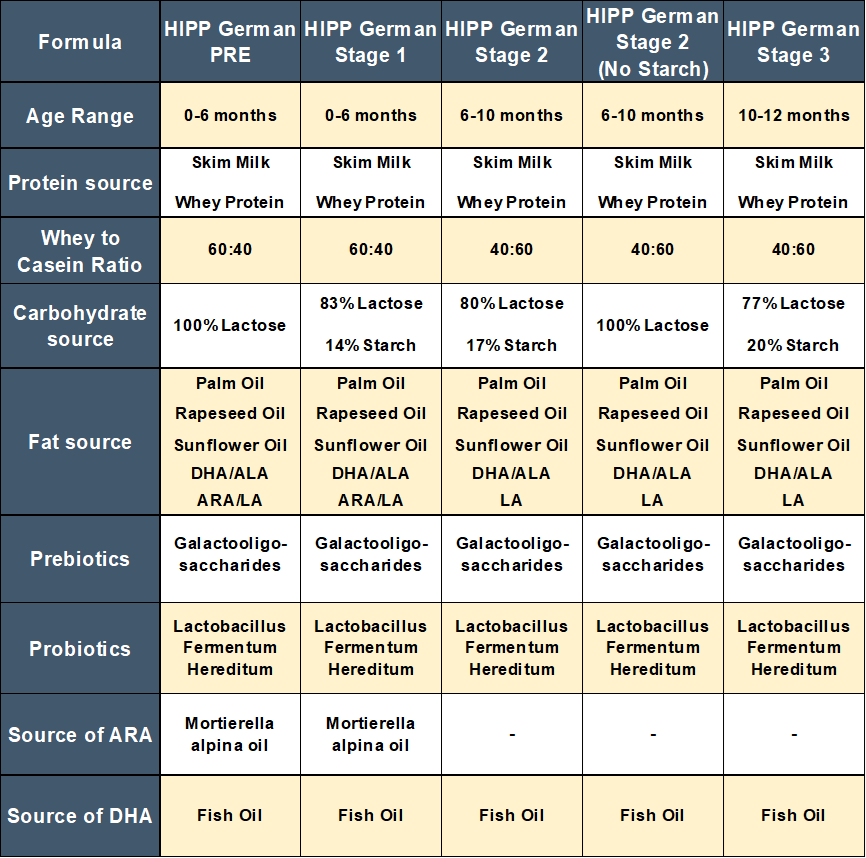
Protein Source:
All five formula stages —HiPP German PRE, Stage 1, Stage 2, Stage 2 (no starch), and Stage 3— share a common protein foundation that consists of skim milk and whey protein. However, a notable distinction lies in the ratio of whey to casein proteins:
- HiPP German PRE and Stage 1:
- Whey to Casein Ratio: 60:40
- Implication: These formulas are higher in whey protein, which is easier to digest and resembles breast milk composition, making them well-suited for newborns and younger infants.
- HiPP German Stage 2, Stage 2 (no starch), and Stage 3:
- Whey to Casein Ratio: 40:60
- Implication: These formulas have a higher proportion of casein protein, which digests more slowly. This profile aligns with the changing nutritional needs of older infants, offering sustained nutrition as they transition to more solid foods.

Carbohydrate Source:
The carbohydrate composition in HiPP German formulas undergoes distinct variations across the different stages:
- HiPP German PRE and Stage 2 (no starch):
- Carbohydrate Source: Exclusively organic lactose
- Implication: These formulas rely solely on organic lactose, a natural sugar found in breast milk, to provide a carbohydrate source. This aligns with the preferences of younger infants and those with potential starch sensitivities.
- HiPP German Stage 1, Stage 2, and Stage 3:
- Carbohydrate Source: Combination of organic lactose and starch
- Starch Percentage: Starch content increases progressively from Stage 1 to Stage 3
- Implication: As infants grow and their dietary requirements evolve, HiPP German formulas introduce a blend of organic lactose and starch. The inclusion of starch contributes to higher energy content and gradual adaptation to more complex carbohydrate sources as babies transition to solid foods.
Related: HiPP Dutch Stage 1 Vs Stage 2 Vs Stage 3: What’s The Difference?
The gradual introduction of starch in the later stages (Stage 1 to Stage 3) reflects the changing nutritional needs of babies as they move through different developmental milestones. While the PRE and Stage 2 (no starch) formulas prioritize organic lactose for ease of digestion, the subsequent stages incorporate starch to accommodate the increased energy demands of older infants.
Fat Source:
HiPP German formulas feature a blend of three essential organic oils: palm oil, rapeseed oil, and sunflower oil. These oils collectively provide a balanced and nourishing source of dietary fat for growing infants.
Organic palm oil contributes energy and essential fatty acids that resemble those found in breast milk. Organic rapeseed oil offers a balanced fatty acid profile particularly alpha linoleic acid, supporting healthy cellular function and aiding in fat-soluble vitamin absorption. Organic sunflower oil, rich in omega-6 fatty acids especially linoleic acid, promotes brain development and immune system health.
The composition of essential fatty acids, along with the consistent blend of fat sources, ensures a well-rounded and tailored nutritional profile for each stage. While DHA, ALA, and LA are present throughout all stages, the presence of ARA exclusively in HiPP German PRE and Stage 1 formulas highlights the focus on early developmental needs.
Prebiotics:
All HiPP German Formulas have a prebiotic called Galactooligosaccharides (GOS) derived from organic lactose that supports digestive health by nourishing beneficial gut bacteria. These fibers promote a balanced gut microbiome, aiding in digestion, softer stools, potential immune support, and even a connection to brain health.
HiPP’s inclusion of GOS reflects its commitment to providing not only essential nutrients but also functional ingredients that contribute to infants’ overall well-being.
Related: HiPP UK Stage 1 vs Stage 2 vs Stage 3: What’s The Difference?
Probiotics:
All HiPP German Formulas have a probiotic called Lactobacillus Fermentum Hereditum that promotes infants’ gut health. It aids digestion and potentially supports immune system development.
Nutrients Comparison:

Micronutrients:
In terms of protein, fat, and carbs we notice that all HiPP German stages have almost the same levels except for Stage 3 which has a high protein content.
Vitamins:
We notice that some vitamins contents are increasing progressively from Stage 1 to Stage 3 like Vitamin D, Vitamin E, Vitamin B6, Niacin, Folic acid, Pantothenic acid, Biotin, and Vitamin C. Some of them decrease progressively from Stage 1 to Stage 3 like Vitamin K and Vitamin B2, whereas others remain the same during all stages like Vitamin A, Vitamin B1, and Vitamin B12.
Furthermore, Choline and Inositol are available only in infant formulas (PRE and Stage 1) while Follow-on formulas don’t.
Related: HiPP Organic Formula VS Enfamil Infant: Which One is The Best?
Minerals:

In terms of minerals, we notice also that HiPP German has increased most mineral levels progressively from Stage 1 to Stage 3 like Calcium, Phosphorus, Magnesium, Iron, Manganese, Potassium, and Fluoride. It’s normal because the more a baby grows, the more minerals he needs, not like US formula, they used the same levels during the whole first year.
Price Comparison:

In terms of price, all HiPP German stages have the same size (600g/21.16 oz) and price (37.99$ / 1.79 /oz). Moreover, the PRE, Stage 1, and Stage 2 (no starch) have a ready-to-feed version.
Where to Buy?
| FORMULA | WHERE TO BUY |
|---|---|
| HiPP German PRE | Buy HERE |
| HiPP German Stage 1 | Buy HERE |
| HiPP German Stage 2 | Buy HERE |
| HiPP German Stage 2 (no starch) | Buy HERE |
| HiPP German Stage 3 | Buy HERE |
Use this Promo Code to get 5% off on your orders: BABYFORMULA5
Conclusion:
For babies between 0-6 months, HiPP PRE is a good choice since it’s soy-free and starch-free and has a good nutrient content compared to Stage 1. Also, the price is the same.
For babies between 6-10 months, HiPP Stage 2 (no starch) is a good choice in case your baby has soy or starch allergy since it’s soy-free and starch-free and has the same nutrient content as Stage 2. Also, it has an RTF version.
For babies between 10-12 months, the only choice in HiPP German formulas is Stage 3 which is not soy-free or starch-free. Thus, if your baby has soy or starch allergy try other countries like Dutch or UK.
I have made a full comparison between all stages of HiPP German, Dutch, and UK in THIS ARTICLE if you want to check.
